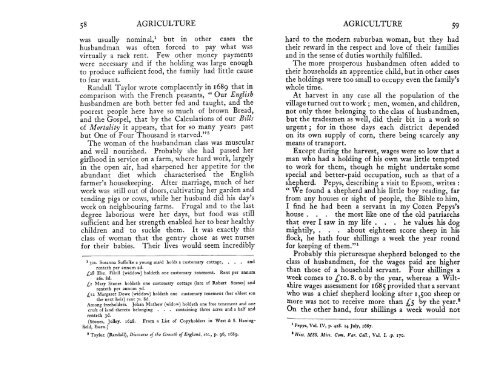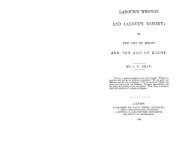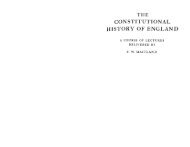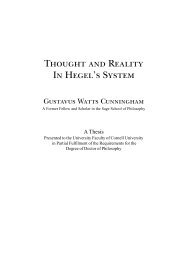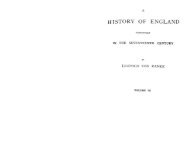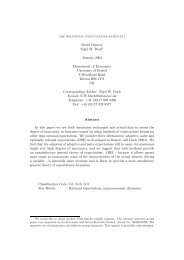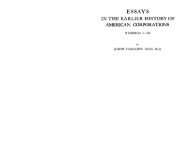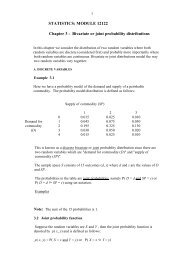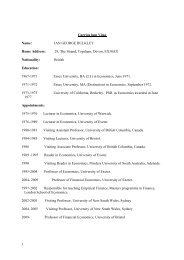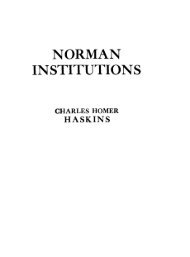56 AGRICULTUREfor colonists in Virginia by the Merchant Taylors who<strong>of</strong>fer "one hundred acres for every man's person thathath a trade, or a body able to endure day labour asmuch for his wief, as much for his child, that are <strong>of</strong>yeres to doe service to the Colony."'B. Husbandmen.Husbandmen were probably the most numerousclass in the village community. Possessed <strong>of</strong> a smallholding at a fixed customary rent and with rights <strong>of</strong>grazing on the common, they could maintain a position<strong>of</strong> independence.Statute 31 Eliz., forbidding the erection <strong>of</strong> cottageswithout four acres <strong>of</strong> land attached, was framed withthe intention <strong>of</strong> protecting the husbandman againstthe encroachments <strong>of</strong> capitalists, for a family whichcould grow its own supply <strong>of</strong> food on four acres <strong>of</strong>land would be largely independent <strong>of</strong> the farmer, as thefather could earn the money for the rent, etc., by<strong>working</strong> only at harvest when wages were highest. Ashowever this seasonal labour was not sufficient for thefarmers' demands, such independence was not whollyto their mind, and they complained <strong>of</strong> the idleness<strong>of</strong> husbandmen who would not work for the wages<strong>of</strong>fered.Thus it was said that " In all or most towns,where the fields lie open there is a new brood <strong>of</strong>upstart intruders or inmates . . . loiterers who willnot work unless they may have such excessive wagesas they themselves desire."' " There is with us nowrather a scarcity than a superfluity <strong>of</strong> servants, theirwages being advanced to such an extraordinary height,that they are likely ere long to be masters and theirmasters servants, many poor husbandmen being forcedto pay near as much to their servants for wages as totheir landlords for rent."s' Clode, (C M ) Merchant Taylors, Vol. I., p 323Pseudonismus, Constderattons concmning Common Ftelds and Enclosurcr, 1654.SPse~donlsmils, A Vtnd~catton <strong>of</strong> the Consrdcratrons concrrntng Common Fieldsand Enclosures. I 656.AGRICULTURE 57The holdings <strong>of</strong> the husbandmen varied fom sevenacres or more to half an acre or even less <strong>of</strong> gardenground, in which as potatoes1 were not yet grown inEngland the crop consisted <strong>of</strong> wheat, barley, rye, oats,or peas. Very likely there was a patch <strong>of</strong> hemp orflax and an apple-tree or two, a cherry tree and someelder-berries in the hedge, with a hive or two <strong>of</strong> beesin a warm corner. Common rights made it possibleto keep sheep and pigs and poultry, and the possession<strong>of</strong> a cow definitely lifted the family above the povertyline.Dorothy Osborne describing her own day to herlover, gives an idyllic picture <strong>of</strong> the maidens tendingcows on the common : " The heat <strong>of</strong> the day is spentin reading or <strong>working</strong>, and about six or seven o'clockI walk out into a common that lies hard by the house,where a great many young wenches keep sheep andcows, and sit in the shade singing <strong>of</strong> ballads. I go tothem and compare their voices and beauties to someancient shepherdesses that I have read <strong>of</strong>, and find avast difference there ; but trust me, I think these areas innocent as those could be. I talk to them and findthey want nothing to make them the happiest peoplein the world but the knowledge that they are so. Mostcommonly, when we are in the midst <strong>of</strong> our discourse,one looks about her, and spies her cows going into thecorn, and then away they all run as if they had wingsat their heels. I, that am not so nimble, stay behind,and when I see them driving home their cattle, Ithink 'tis time for me to retire too."2Husbandmen have been defined as a class whocould not subsist entirely upon their holdings, butmust to some extent work for wages. Their need forwages varied according to the size <strong>of</strong> their holdingand according to the rent. For copy-holders the rent' Potatoes were already in use in Ireland, but are tcarcely referred to during thisperiod by Engllsh wnters.' O~borru (Dorotby), Lcttm, pp. 103,q. 1652-1654.
5 8 AGRICULTURE AGRICULTURE 59was usually nominal,' but in other cases thehusbandman was <strong>of</strong>ten forced to pay what wasvirtually a rack rent. Few other money paymentswere necessary and if the holding was large enoughto produce sufficient food, the family had little causeto fear want.Randall Taylor wrote complacently in 1689 that incomparison with the French peasants, " Our Englishhusbandmen are both better fed and taught, and thepoorest people here have so much <strong>of</strong> brown Bread,and the Gospel, that by the Calculations <strong>of</strong> our Bills<strong>of</strong> Mortality it appears, that for so many years pastbut One <strong>of</strong> Four Thousand is starved."'The woman <strong>of</strong> the husbandman class was muscularand well nourished. Probably she had passed hergirlhood in service on a farm, where hard work, largelyin the open air, had sharpened her appetite for theabundant diet which characterised the Englishfarmer's housekeeping. After marriage, much <strong>of</strong> herwork was still out <strong>of</strong> doors, cultivating her garden andtending pigs or cows, while her husband did his day'swork on neighbouring farms. Frugal and to the lastdegree laborious were her days, but food was stillsufficient and her strength enabled her to bear healthychildren and to suckle them. It was exactly thisclass <strong>of</strong> woman that the gentry chose as wet nursesfor their babies. Their lives would seem incredibly. . . andl 30s. Susanna Suffolke a young maid holds a customary cottage,renteth per annum 2d.A28 Elm. Filoll (widdow) holdeth one customary tenement. Rent per annum26s. 8d.At May Stanes holdeth one customary cottage (late <strong>of</strong> Robert Stanes) andrenteth per annum 7d.A12 Margaret Dowe (widdow) holdeth one customary tenement (her eldest sonthe next heir) rent 7s. 8d.Among freeholders. Johan Mathew (widow) holdeth one free tenement and onecr<strong>of</strong>t <strong>of</strong> land thereto belonging . . . containing three acres and a half andrenteth 3d.(Stones, Joiley. 1628. From a List <strong>of</strong> Copyholders in West & S. Haningfield,Essex.)' Taylor. (Randall), Discourse <strong>of</strong> the Growth $England, etc., p. 96, 1689.hard to the modern suburban woman, but they hadtheir reward in the respect and love <strong>of</strong> their familiesand in the sense <strong>of</strong> duties worthily fulfilled.The more prosperous husbandmen <strong>of</strong>ten added totheir households an apprentice child, but in other casesthe holdings were too small to occupy even the family'swhole time.At harvest in any case all the population <strong>of</strong> thevillage turned out to work ; men, <strong>women</strong>, and children,not only those belonging to the class <strong>of</strong> husbandmen,but the tradesmen as well, did their bit in a work sourgent ; for in those days each district dependedon its own supply <strong>of</strong> corn, there being scarcely anymeans <strong>of</strong> transport.Except during the harvest, wages were so low that aman who had a holding <strong>of</strong> his own was little temptedto work for them, though he might undertake somespecial and better-paid occupation, such as that <strong>of</strong> ashepherd. Pepys, describing a visit to Epsom, writes :" We found a shepherd and his little boy reading, farfrom any houses or sight <strong>of</strong> people, the Bible to him,I find he had been a servant in my Cozen Pepys'shouse . . . the most like one <strong>of</strong> the old patriarchsthat ever I saw in my <strong>life</strong> . . . he values his dogmightily, . . . about eighteen score sheep in hisflock, he hath four shillings a week the year roundfor keeping <strong>of</strong> them."'Probably this picturesque shepherd belonged to theclass <strong>of</strong> husbandmen, for the wages paid are higherthan those <strong>of</strong> a household servant. Four shillings aweek comes to EIO. 8. o by the year, whereas a Wiltshirewages assessment for 1685 provided that a servantwho was a chief shepherd looking after I ,500 sheep ormore was not to receive more than by the year.=On the other hand, four shillings a week would not' Pepys, Vol. IV, p. 428. 14 July, 1667.' Hirt. MSS. ~ iss. Corn. Yar. COU., vol. I. .p. 170.
- Page 1 and 2: WORKING LIFE OF WOMENIN THESEVENTEE
- Page 6 and 7: 4 INTRODUCTORYtragic class of wage
- Page 8 and 9: 8 INTRODUCTORY INTRODUCTORYDomestic
- Page 10 and 11: INTRODUCTORYunmarried girls go out
- Page 12 and 13: I 6 CAPITALISTS CAPITALISTS" I loos
- Page 14 and 15: CAPITALISTSweak woman stands in the
- Page 16 and 17: 24 CAPITALISTS CAPITALISTS 25wife t
- Page 18 and 19: 2 8 CAPITALISTS CAPITALISTS 29Majes
- Page 20 and 21: 32 CAPITALISTSA warrant was issued"
- Page 22 and 23: CAPITALISTSbusiness. " At O~tend, N
- Page 24 and 25: CAPITALISTS CAPITALISTS41thro' her
- Page 26 and 27: AGRICULTUREwas made of their develo
- Page 28 and 29: AGRICULTUREis not drye as it should
- Page 30 and 31: 52 AGRICULTURE AGRICULTUREhave of h
- Page 34 and 35: AGRICULTUREmaintain completely the
- Page 36 and 37: 64 AGRICULTUREtime was well spent i
- Page 38 and 39: AGRICULTUREExcept in exeptional cir
- Page 40 and 41: 72 AGRICULTURE AGRICULTURE 73mainta
- Page 42 and 43: 76 AGRICULTUREfor the impotent poor
- Page 44 and 45: AGRICULTUREwhich we can imagine tha
- Page 46 and 47: AGRICULTURE AGRICULTURE 85by his se
- Page 48 and 49: AGRICULTUREher work, but generosity
- Page 50 and 51: AGRICULTUREwife of Thos. Lyne. Toba
- Page 52 and 53: TEXTILESwas paid better than the la
- Page 54 and 55: TEXTILESroof provided them with the
- Page 56 and 57: 104 TEXTILESformulated by 25 Charle
- Page 58 and 59: 108 TEXTILES TEXTILES 109until the
- Page 60 and 61: TEXTILESon spinning for their livin
- Page 62 and 63: TEXTILESstill and dry within Doors,
- Page 64 and 65: 120 TEXTILES TEXTILESthe cloth made
- Page 66 and 67: 124TEXTILES TEXTILESin the closely
- Page 68 and 69: TEXTILESKingdom, it required a grea
- Page 70 and 71: 132 TEXTILES TEXTILESnot exceedl6 1
- Page 72 and 73: TEXTILES TEXTILES I37hours in four
- Page 74 and 75: ---P-I 4OTEXTILEScan be quoted of t
- Page 76 and 77: '44 TEXTILES TEXTILESWood Streate,
- Page 78 and 79: TEXTILEShigher wages than would hav
- Page 80 and 81: 1 52 CRAFTS AND TRADESdebts. For ex
- Page 82 and 83:
I 56 CRAFTS AND TRADES CRAFTS AND T
- Page 84 and 85:
160 CRAFTS AND TRADES CRAFTS AND TR
- Page 86 and 87:
164 CRAFTS AND TRADESAmong thirty-n
- Page 88 and 89:
CRAFTS AND TRADESalso met with as b
- Page 90 and 91:
172 CRAFTS AND TRADES CRAFTS AND TR
- Page 92 and 93:
176 CRAFTS AND TRADESto Henry Joyce
- Page 94 and 95:
180 CRAFTS AND TRADES CRAFTS AND TR
- Page 96:
CRAFTS AND TRADESWardens and Brothe
- Page 99 and 100:
P-I9OCRAFTS AND TRADESmarriage ; it
- Page 101 and 102:
CRAFTS AND TRADEStaken our goods fr
- Page 103 and 104:
1g8CRAFTS AND TRADESresources turne
- Page 105 and 106:
CRAFTS AND TRADESThere were fewer r
- Page 107 and 108:
206 CRAFTS AND TRADES CRAFTS AND TR
- Page 109 and 110:
CRAFTS AND TRADESA large proportion
- Page 111 and 112:
214CRAFTS AND TRADES CRAFTS AND TRA
- Page 113 and 114:
218 CRAFTS AND TRADES CRAFTS AND TR
- Page 115 and 116:
222 CRAFTS AND TRADES CRAFTS AND TR
- Page 117:
CRAFTS AND TRADES CRAFTS AND TRADES
- Page 120 and 121:
CRAFTS AND TRADESfrom her fellow pa
- Page 122 and 123:
PROFESSIONS 237PROFESSIONSIntroduct
- Page 124 and 125:
24O PROFESSIONS PROFESSIONStheir Th
- Page 126 and 127:
244 PROFESSIONS PROFESSIONS 245the
- Page 128 and 129:
PROFESSIONS PROFESSIONS 249profanat
- Page 130 and 131:
252PROFESSIONSGiles Moore enters in
- Page 132 and 133:
PROFESSIONScribed as one who " dist
- Page 134 and 135:
PROFESSIONS PROFESSIONS 261first ma
- Page 136 and 137:
264 PROFESSIONSGarrett's leg shall
- Page 138 and 139:
268 PROFESSIONSwhere there are none
- Page 140 and 141:
PROFESSIONS PROFESSIONS 273the numb
- Page 142 and 143:
PROFESSIONSexaminations, before six
- Page 144 and 145:
PROFESSIONS PROFESSIONS 281death me
- Page 146 and 147:
284 PROFESSIONS PROFESSIONSof confi
- Page 148 and 149:
288 PROFESSIONSextent they were whe
- Page 150 and 151:
CONCLUSIONor in her other facilitie
- Page 152 and 153:
CONCLUSION CONCLUSION 297in women's
- Page 154 and 155:
CONCLUSIONlaw of Nature, inviolable
- Page 156 and 157:
CONCLUSIONwere specially deprecated
- Page 158 and 159:
308 CONCLUSIONof the State, and the
- Page 160 and 161:
312 AUTHORITIES AUTHORITIES 313Cost
- Page 162 and 163:
AUTHORITIESMartindale, Adam, The Li
- Page 164 and 165:
County.Buckingham ..Cardigan .. ..C
- Page 166 and 167:
INDEXINDEXFlax, 64, 146, 246, 291 ;
- Page 168:
INDEXsmants, women( 50,65,157 ; mam


